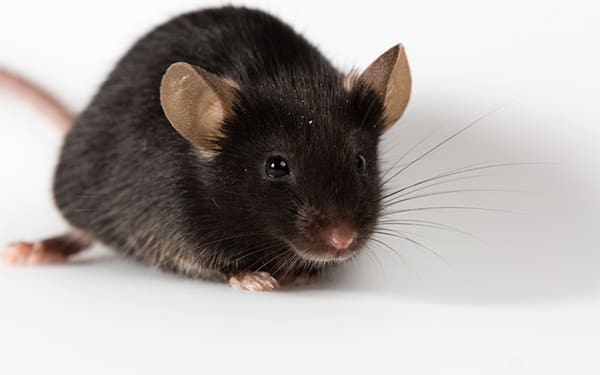Rag1 KO mice
Rag1 KO mice
| Strain details | |
|---|---|
| Nomenclature | B6.SVJ129-Rag1tm1Bal/Ozarc |
| Common name | Rag1-KO |
| Synonyms | Black N10, RAG1 N10, RAG KO, Rag1 -/- |
| Strain | Mutant inbred |
| Coat Colour | Black (a/a) |
| Species | Mouse |
| Genetic background | C57BL/N10 |
| Location | Vivarium 1 |
| Supply | Tier 2: pre-allocation, breed on request |
Strain description
- MCH haplotype: H2K b
- Complement factor: C5 normal
- Rag1-deficient (Rag1-/-) mice are an immunodeficient stock strain that lack functional B and T lymphocytes.
- Rag1 (recombination activation gene) is one of two activation genes for V(D)J recombination which occurs at seven unique loci including loci in mature B and T lymphocytes.
- Mice that are homozygous for the Ragtm1Bal mutation express a non-leaky severe combined immune deficiency phenotype (Prkdcscid/Prkdcscid) and contain 15–130 times fewer cells in the thymus.
- Thymocytes of Rag1-/- mice are larger than the heterozygous and wildtype equivalents and produce no CD3+ or T-cell receptor ab-positive (TCRab+) cells.
- Homozygous Rag-1 deficient mice appear healthy and are indistinguishable from heterozygous and wildtype littermates despite being immunodeficient.
- Both male and female homozygous mice are fertile and produce viable offspring.
- Old mice can develop inclusion body nephropathy.
- In order to accommodate their level of immunodeficiency, Rag1-deficient mice are maintained at Ozgene ARC in a maximum barrier environment, housed within individually ventilated cages (IVC).
- Strain of Origin is 129S4/SvJae then backcrossed on C57BL/6J to N10 at ARC.
- This stock strain is highly applicable to a range of autoimmune research fields.
Past ARC and transfer reports:
Current Ozgene ARC reports (from 01-Jun-2023)
- Please see on our Biosecurity page
- Animals are not allowed to be used for propagation
- Ozgene ARC terms and Conditions
- Mouse images are representative only. Actual phenotypes may vary based on genotype, sex, age, husbandry, health status, and other factors.
- Rios FJ, et al. Hypertension. 2020 Apr;75(4):935-937. PMID: 32078397 doi: 10.1161/HYPERTENSIONAHA.119.14406. Lessons Learned From RAG-1-Deficient Mice in Hypertension
- Hang S, et al. Cell Press. 2019 Oct 31;179(4):694-712. PMID: 31675492 doi: 10.1016/j.cell.2019.10.012. The Immune-Mind Connection.
- Spanopoulou E, Roman CA, Corcoran LM, Schlissel MS, Silver DP, Nemazee D, Nussenzweig MC, Shinton SA, Hardy RR, Baltimore D. Functional immunoglobulin transgenes guide ordered B-cell differentiation in Rag-1-deficient mice. Genes Dev. 1994 May 1;8(9):1030-42. doi: 10.1101/gad.8.9.1030. PMID: 7926785.
Rag1 KO Mice: Key model for immunodeficiency and immune system research
The Rag1 KO mice (Rag1 knockout) are an immunodeficient stock strain that lack functional B and T lymphocytes. The Rag1 gene (recombination activating gene 1) is crucial for the V(D)J recombination process, which is essential for the development of diverse antigen receptors on B and T cells. The deletion of the Rag1 gene results in a complete absence of mature B and T lymphocytes, leading to severe immunodeficiency.
The Rag1 KO mice are valuable in studying immune system function, autoimmune diseases, and the development of the adaptive immune response. These mice are also used in transplantation research and as models for human immune-related diseases due to their lack of an adaptive immune response.
Application and Research
- Immune system research: Rag1 KO mice are instrumental in understanding the roles of B and T cells in the immune system. Researchers use these mice to study the development and function of the adaptive immune response.
- Autoimmune disease models: These mice are used to investigate the mechanisms of autoimmune diseases and to develop and test new therapies aimed at modulating immune responses.
- Tissue and organ transplantation: The absence of mature B and T cells in Rag1 KO mice makes them ideal recipients for human tissue and organ transplants, enabling studies on graft acceptance, rejection, and tolerance.
- Gene function studies: Rag1 KO mice provide insights into the role of the Rag1 gene in immune cell development. These mice are used to investigate the effects of genetic mutations on the immune system and overall health.
- Gene therapy studies: Researchers use Rag1 KO mice to evaluate potential gene therapy approaches aimed at restoring immune function in individuals with genetic immunodeficiencies.
- Immune-mind connection: Studies using Rag1 KO mice explore the relationship between the immune system and behavior, providing insights into how immune deficiencies can affect neurological function and behavior.
- Cardiovascular disease: Rag1 KO mice are employed in studying the role of immune responses in cardiovascular diseases, including hypertension, atherosclerosis, and aneurysms.


